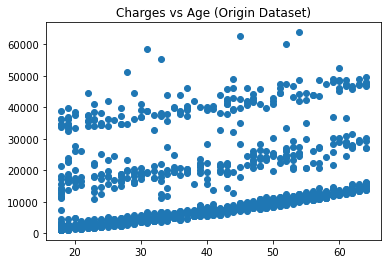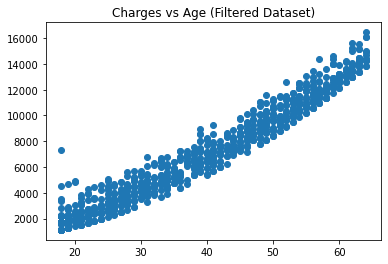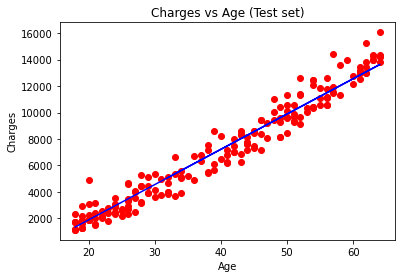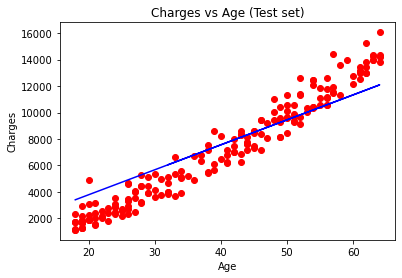机器学习—回归2-1(简单线性回归)
使用简单线性回归根据年龄预测医疗费用
主要步骤流程:
- 1. 导入包
- 2. 导入数据集
- 3. 数据预处理
- 3.1 检测缺失值
- 3.2 筛选数据
- 3.3 得到自变量和因变量
- 3.4 拆分训练集和测试集
- 4. 构建不同参数的简单线性回归模型
- 4.1 模型1:构建简单线性回归模型
- 4.1.1 构建简单线性回归模型
- 4.1.2 得到模型线性表达式
- 4.1.3 预测测试集
- 4.1.4 得到模型MSE
- 4.1.5 可视化测试集
- 4.2 模型2:构建简单线性回归模型
- 4.3 模型3:构建简单线性回归模型
- 4.1 模型1:构建简单线性回归模型
1. 导入包
In [2]:
# 导入包
import numpy as np
import pandas as pd
import matplotlib.pyplot as plt
2. 导入数据集
In [3]:
# 导入数据集
data = pd.read_csv('insurance.csv')
data.head(5)
Out[3]:
3. 数据预处理
3.1 检测缺失值
In [4]:
# 检测缺失值
null_df = data.isnull().sum()
null_df
Out[4]:
3.2 筛选数据
In [5]:
# 画出age和charges的散点图
plt.figure()
plt.scatter(data['age'], data['charges'])
plt.title('Charges vs Age (Origin Dataset)')
plt.show()

In [6]:
# 筛选数据
new_data_1 = data.query('age<=40 & charges<=10000') # 40岁以下 且 10000元以下
new_data_2 = data.query('age>40 & age<=50 & charges<=12500') # 40岁至50岁之间 且 12500元以下
new_data_3 = data.query('age>50 & charges<=17000') # 50岁以上 且 17000元以下
new_data = pd.concat([new_data_1, new_data_2, new_data_3], axis=0)
In [7]:
# 画出age和charges的散点图
plt.figure()
plt.scatter(new_data['age'], new_data['charges'])
plt.title('Charges vs Age (Filtered Dataset)')
plt.show()
In [8]:
# 检查age和charges的相关性
print('age和charges的相关性是:\n', np.corrcoef(new_data['age'], new_data['charges']))
age和charges的相关性是:
[[1. 0.97552029]
[0.97552029 1. ]]
3.3 得到自变量和因变量
In [9]:
# 得到自变量和因变量
x = new_data.iloc[:, 0:1].values
y = new_data['charges'].values
3.4 拆分训练集和测试集
In [10]:
# 拆分训练集和测试集
from sklearn.model_selection import train_test_split
x_train, x_test, y_train, y_test = train_test_split(x, y, test_size = 0.2, random_state = 1)
print(x_train.shape)
print(x_test.shape)
print(y_train.shape)
print(y_test.shape)
4. 构建不同参数的简单线性回归模型
4.1 模型1:构建简单线性回归模型
4.1.1 构建简单线性回归模型
In [11]:
# 构建不同参数的简单线性回归模型
# 模型1:构建线性回归模型(normalize = True, fit_intercept = True)
from sklearn.linear_model import LinearRegression
regressor = LinearRegression(normalize = True, fit_intercept = True)
regressor.fit(x_train, y_train)
Out[11]:
4.1.2 得到模型线性表达式
In [12]:
# 得到线性表达式: Charges = a * Age + b
print('Charges = %.2f * Age + (%.2f)' %(regressor.coef_, regressor.intercept_))
4.1.3 预测测试集
In [13]:
# 预测测试集
y_pred = regressor.predict(x_test)
4.1.4 得到模型MSE
In [14]:
# 得到模型的MSE
from sklearn.metrics import mean_squared_error
mse_score = mean_squared_error(y_test, y_pred)
print('简单线性回归模型的MSE是:%.2f' %(mse_score)) # 738,002.02
4.1.5 可视化测试集
In [15]:
# 可视化测试集
plt.scatter(x_test, y_test, color = 'red')
plt.plot(x_test, y_pred, color = 'blue')
plt.title('Charges vs Age (Test set)')
plt.xlabel('Age')
plt.ylabel('Charges')
plt.show()
4.2 模型2:构建简单线性回归模型
In [16]:
# 模型2:构建线性回归模型(normalize = False, fit_intercept = True)
regressor = LinearRegression(normalize = False, fit_intercept = True)
regressor.fit(x_train, y_train)
Out[16]:
In [17]:
# 得到线性表达式: Charges = a * Age + b
print('Charges = %.2f * Age + (%.2f)' %(regressor.coef_, regressor.intercept_))
In [18]:
# 预测测试集
y_pred = regressor.predict(x_test)
In [19]:
# 得到模型的MSE
mse_score = mean_squared_error(y_test, y_pred)
print('简单线性回归模型的MSE是:%.2f' %(mse_score)) # 738,002.02
In [20]:
# 可视化测试集
plt.scatter(x_test, y_test, color = 'red')
plt.plot(x_test, y_pred, color = 'blue')
plt.title('Charges vs Age (Test set)')
plt.xlabel('Age')
plt.ylabel('Charges')
plt.show()
4.3 模型3:构建简单线性回归模型
In [21]:
# 模型3:构建线性回归模型(normalize = False, fit_intercept = False)
regressor = LinearRegression(normalize = False, fit_intercept = False)
regressor.fit(x_train, y_train)
Out[21]:
In [22]:
# 得到线性表达式: Charges = a * Age + b
print('Charges = %.2f * Age' %(regressor.coef_))
In [23]:
regressor.intercept_
Out[23]:
In [24]:
# 预测测试集
y_pred = regressor.predict(x_test)
In [25]:
# 得到模型的MSE
mse_score = mean_squared_error(y_test, y_pred)
print('简单线性回归模型的MSE是:%.2f' %(mse_score)) # 2,404,889.50
In [26]:
# 可视化测试集预测结果
plt.scatter(x_test, y_test, color = 'red')
plt.plot(x_test, y_pred, color = 'blue')
plt.title('Charges vs Age (Test set)')
plt.xlabel('Age')
plt.ylabel('Charges')
plt.show()
结论: 1)由上图可见,模型为样本点拟合了一条直线;
2)传入模型不同的参数,模型的性能不同;









 浙公网安备 33010602011771号
浙公网安备 33010602011771号